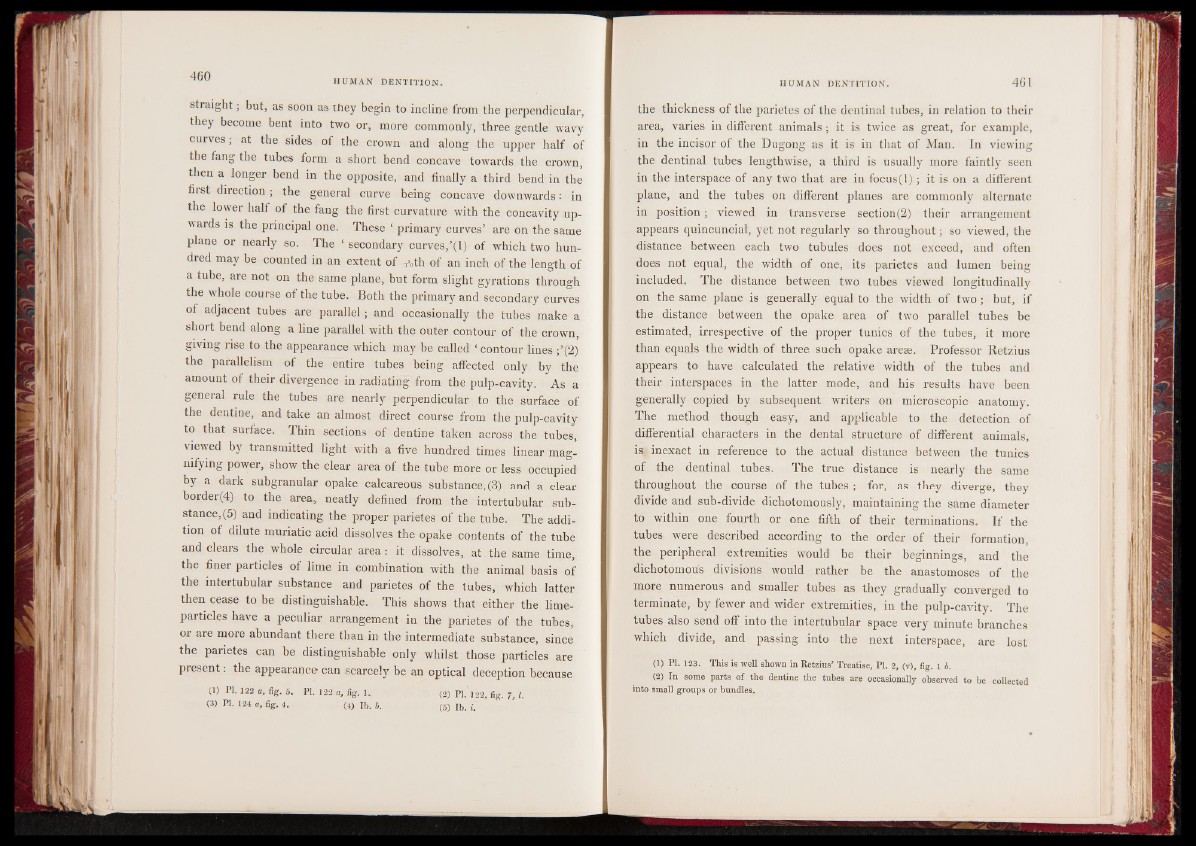
straight; but, as soon as they begin to incline from the perpendicular,
they become bent into two or, more commonly, three gentle wavy
curves; at the sides of the crown and along the upper half of
the fang the tubes form a short bend concave towards the crown,
then a longer bend in the opposite, and finally a third bend in the
first direction; the general curve being concave downwards: in
the lower half of the fang the first curvature with the concavity upwards
is the principal one. These ‘ primary curves’ are on the same
plane or nearly so. The ‘ secondary curves,’(1) of which two hundred
may be counted in an extent of Tvth of an inch of the length of
a tube, are not on the same plane, but form slight gyrations through
the whole course of the tube. Both the primary and secondary curves
of adjacent tubes are parallel; and occasionally the tubes make a
short bend along a line parallel with the outer contour of the crown,
giving rise to the appearance which may be called ‘ contour lines ;’(2)
the parallelism of the entire tubes being affected only by the
amount of their divergence in radiating from the pulp-cavity. As a
general rule the tubes are nearly perpendicular to the surface of
the dentine, and take an almost direct course from the pulp-cavity
to that surface. Thin sections of dentine taken across the tubes,
viewed by transmitted light with a five hundred times linear magnifying
power, show the clear area of the tube more or less occupied
by a dark subgranular opake calcareous substance, (3) and a clear
border(4) to the area, neatly defined from the intertubular substance,
(5) and indicating the proper parietes of the tube. The addition
of dilute muriatic acid dissolves the opake contents of the tube
and clears the whole circular area : it dissolves, at the same time,
the finer particles of lime in combination with the animal basis of
the intertubular substance and parietes of the tubes, which latter
then cease to be distinguishable. This shows that either the lime-
particles have a peculiar arrangement in the parietes of the tubes,
or are more abundant there than in the intermediate substance, since
the parietes can be distinguishable only whilst those particles are
present j the appearance can scarcely be an optical deception because
(1) PI. 122 a, fig. 5. PI. 122 a, fig. 1. (2) PI.’122, fig. 7, l.
(3) PI. 124 a, fig. 4. (4) lb. 5. (5) lb. i.
the thickness of the parietes of the dentinal tubes, in relation to their
area, varies in different animals ; it is twice as great, for example,
in the incisor of the Dugong as it is in that of Man. In viewing
the dentinal tubes lengthwise, a third is usually more faintly seen
in the interspace of any two that are in focus (1); it is on a different
plane, and the tubes on different planes are commonly alternate
in position; viewed in transverse section(2) their arrangement
appears quincuncial, yet not regularly so throughout; so viewed, the
distance between each two tubules does not exceed, and often
does not equal, the width of one, its parietes and lumen being
included. The distance between two tubes viewed longitudinally
on the same plane is generally equal to the width of two; hut, if
the distance between the opake area of two parallel tubes be
estimated, irrespective of the proper tunics of the tubes, it more
than equals the width of three such opake arese. Professor Retzius
appears to have calculated the relative width of the tubes and
their interspaces in the latter mode, and his results have been
generally copied by subsequent writers on microscopic anatomy.
The method though easy, and applicable to the detection of
differential characters in the dental structure of different animals,
is; inexact in reference to the actual distance between the tunics
of the dentinal tubes. The true distance is nearly the same
throughout the course of the tubes ; for, as they diverge, they
divide and sub-divide dichotomously, maintaining the same diameter
to within one fourth or one fifth of their terminations. If the
tubes were described according to the order of their formation,
the peripheral extremities would be their beginnings, and the
dichotomous divisions would rather be the anastomoses of the
more numerous and smaller tubes as they gradually converged to
terminate, by fewer and wider extremities, in the pulp-cavity. The
tubes also send off into the intertubular space very minute branches
which divide, and passing into the next interspace, are lost
(1) PI. 123. This is well shown in Retzius’ Treatise, PI. 2, (v), fig. l b.
(2) In some parts of the dentine the tubes are occasionally observed to be collected
into small groups or bundles.